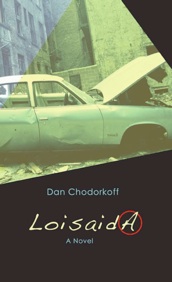 Review of Loisaida, by Dan Chodorkoff
Review of Loisaida, by Dan Chodorkoff
Burlington: Fomite Press, 2011, 338 pp.
http://www.fomitepress.com/FOMITE/Loisaida.html
In the 1980s, the fabled Lower East Side of Manhattan was in a time of transition. There were still substantial remnants of the old immigrant cultures that forged the neighborhood’s identity in the early 20th century, even as its zeitgeist had been significantly reshaped by the Puerto Rican influx of the sixties and seventies. The forces of gentrification—which in subsequent decades have turned nearly all of Manhattan into a wealthy enclave—were just beginning to discover what this neighborhood, just east of Greenwich Village, had to offer. So there were Ukrainian cafeterias and Jewish clothing shops, bodegas and boutiques, not to mention a few early latte bars, all trying to coexist in a rather unstable not-quite-melting-pot.
Into this rather turbulent mix, an influx of anarchist-inspired squatters had begun to occupy abandoned buildings and try to create new models of urban homesteading. Sometimes they collaborated with the Puerto Rican activists to establish sweat equity, build community gardens, and resist the most aggressive developers. Often they looked upon each other with some disdain: the anarchists, like the hippies that had swarmed the “East Village” in past decades were often refugees from affluent suburbia, and the Puerto Ricans just weren’t militant or politically correct enough for some of the squatters.
This is the setting of Dan Chodorkoff’s Loisaida, a compelling coming-of-age story that describes one young woman’s journey of self-discovery and political awakening. Purple-haired Catherine is one of those suburban refugees. She’s escaped a liberal but far too safe enclave in Scarsdale to live with her lover in a Lower East Side squat and work on an anarchist newspaper, the well-intentioned but rhetorically excessive
Avalanche. One of those community gardens—in this case established by Puerto Rican activists but recently more frequented by the anarchists and punk rockers—is slated for demolition under the pretext of building low income housing. The neighborhood becomes even more polarized, and Catherine begins to find her voice. Chodorkoff, who co-founded the Institute for Social Ecology in Vermont, but lived and worked in the Lower East Side for most of the eighties, knows the scene well, and draws abundantly from many of the people he knew and worked with during those years.
It’s a fascinating cast of characters that will immediately resonate with anyone who’s even casually familiar with the New York of decades past. There’s the former gang leader who’s become the neighborhood’s most effective and charismatic organizer—a character modeled after Chodorkoff’s close friend Chino Garcia—and another “reformed” gang leader who’s instead become a corrupt politician. There’s the ex-Yippie newspaper publisher with a pronounced authoritarian streak, the single mom seeking a better life for herself and her young son, and all manner of street poets, drug dealers, radical puppeteers, and other young idealists. But in Chodorkoff’s skillful words, filled with love and affection for these people and their neighborhood, they’re far from just archetypes; they become a fascinating slice of humanity struggling with life in changing times. We experience the joys, the sensations, the pleasures and the fears of a New York in the midst of upheaval and transition.
As the events of Loisaida unfold (the title is a kind of Spanglish rendering of “Lower East Side” that became popular during those years), we are drawn into the complexities and uncertainties of this world. People are idealistic, but quite naïve; courageous, but sometimes irrepressibly macho; determined to do the right thing, but caught up in the norms of various subcultures that make it hard to see how the world looks from others’ eyes. There are moments of revelation, and of real suspense, as people try to reach beyond their differences to save the neighborhood.
The character who ties it all together, embodies the neighborhood’s history, and guides Catherine on her journey of awakening is her great grandmother, Sonia, a refugee from czarist Russia who settled in the neighborhood at the dawn of the 20th century. Sonia was at the center of the labor agitation of the early part of the century, and of efforts to keep the radical traditions alive through decades of war, repression and cultural isolation. We visit her, with Catherine, in her nursing home, and also get to read striking highlights of the oral history she recorded for Catherine’s father during the height of his own 1960s idealism. As Catherine discovers her family’s hidden past, we discover a time when people devoted every moment of their lives to creating a better world.
Sonia also introduces Catherine to Jack Hoffman, a generation younger than Sonia, and in the forefront of the emerging urban ecological awareness of the period. The Hoffman character, of course, is partly modeled after Chodorkoff’s close friend and mentor, Murray Bookchin, the founding theorist of social ecology, and shares Bookchin’s acerbic personality, as well as his incomparable mind for social critique and grand theoretical synthesis. What Sonia provides through her stories, Hoffman reinforces with his reflections on what it means to live for an idea and dedicate one’s life to a coherent vision of a better world. With Catherine, we come to see what it means to reach beyond the limitations of the activist youth scene, with its thrills of living for the moment, and to dedicate oneself to the long haul of social transformation. Loisaida is essential and engaging reading for anyone interested in New York, youth cultures, the evolution of popular radicalism, or just looking for a good story.
Brian Tokar is the current director of the Institute for Social Ecology (social-ecology.org) and a lecturer in environmental studies at the University of Vermont. His most recent books are Toward Climate Justice (New Compass Press, 2010, distributed by AK Press) and Agriculture and Food in Crisis (co-edited with Fred Magdoff, Monthly Review Press, 2010).
